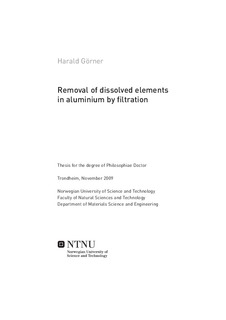| dc.contributor.author | Görner, Harald | nb_NO |
| dc.date.accessioned | 2014-12-19T13:25:29Z | |
| dc.date.available | 2014-12-19T13:25:29Z | |
| dc.date.created | 2010-06-23 | nb_NO |
| dc.date.issued | 2009 | nb_NO |
| dc.identifier | 326596 | nb_NO |
| dc.identifier.isbn | 978-82-471-1854-2 (printed ver.) | nb_NO |
| dc.identifier.isbn | 978-82-471-1855-9 (electronic ver.) | nb_NO |
| dc.identifier.uri | http://hdl.handle.net/11250/248836 | |
| dc.description.abstract | The objective of this work was to show that removal of alkali from aluminium melts by means of filtration is feasible. Therefore, a chemically active filter based on a packed bed of AlF3 grains was designed and built. Varying parameters like contact area, impurity level, residence time and temperature, pure aluminium melts as well as two different AlMg–alloys containing different levels of Na or Ca were filtered to reveal the kinetics of the AlF3 filter material. Filtration experiments performed on a laboratory scale using AlF3 filter grains in a packed bed gave high removal rates for alkali metals such as Na and Ca following first order kinetics. Removal was between ~50% and ~95% for a dimensionless contact area A* increasing from ~1 to ~2, respectively. An empirical expression for the total mass transfer coefficient to be expected for the removal of Ca at a certain velocity of pure molten aluminium was determined. Further it could be shown that the elements removed are retained in the AlF3 filter. | nb_NO |
| dc.language | eng | nb_NO |
| dc.publisher | NTNU | nb_NO |
| dc.relation.ispartofseries | Doktoravhandlinger ved NTNU, 1503-8181; 2009:225 | nb_NO |
| dc.title | Removal of dissolved elementsin aluminium by filtration | nb_NO |
| dc.type | Doctoral thesis | nb_NO |
| dc.contributor.department | Norges teknisk-naturvitenskapelige universitet, Fakultet for naturvitenskap og teknologi, Institutt for materialteknologi | nb_NO |
| dc.description.degree | PhD i materialteknologi | nb_NO |
| dc.description.degree | PhD in Materials Technology | en_GB |
